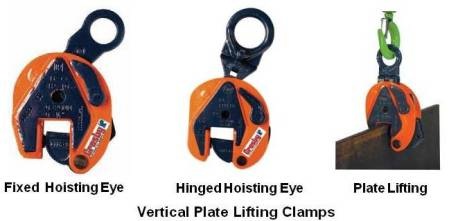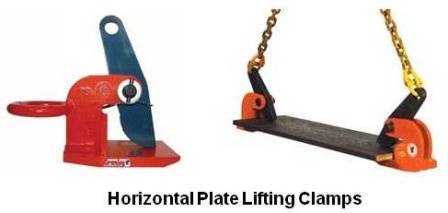For handling plates or fabrications, plate lifting clamps are used. Information about their application is given in this article.
These clamps shall be designed to have ultimate load to be 5 times the Working Load Limit and shall be proof tested to 2 times the Working Load Limit. Generally they have welded alloy steel body and forged alloy components for strength and smaller size. Two types of clamps are used for handling plates or fabrications. They are vertical lifting clamps and horizontal lifting clamps as under.
Vertical Lifting Clamps

Vertical lifting clamp is used for the lifting, turning, moving or vertical transfer of sheet, plates, or fabrications from horizontal to vertical and down to horizontal (180°) as needed.
Fixed hoisting eye clamp is used as a single point pick or when used with a spreader beam with multiple vertical drop lines.
The hinged hoisting eye allows for the clamp to place and lift the load from any direction, or with a multiple leg sling with out side loading the clamp.
They are available in a variety of styles as under.
Standard clamp for materials with a surface hardness to 37Rc (345 HB).
Larger jaw opening.
For use with Stainless Steel material.
For use with materials with a surface hardness to 47Rc (450 HB).
Non-Marring type clamps will not mar, or scratch the material surface. Use them for Materials such as aluminum, stainless steel, painted materials, aircraft skins, composite material, glass, plastic, etc.
Note: Check for Minimum WLL for these clamps. Generally they have Minimum WLL of 10% of Maximum WLL.
Horizontal Lifting Clamps
Horizontal lifting clamps with spring loaded tension have a pretension feature that allows the user to attach the clamps to the material for horizontal lifting and transfer of sagging and nonsagging material. These clamps must be used in pairs or more as shown below.

Non-Marring type clamps will not mar, or scratch the material surface.
If clamps are not fitted with spring loaded tension to have a pretension, check adequacy of its design to handle sagging material.
Acknowledgements:
This article is written based on information in Crosby’s General Catalog. For other types of clamps like beam clamps, drum clamps, etc. please refer their catalog.
